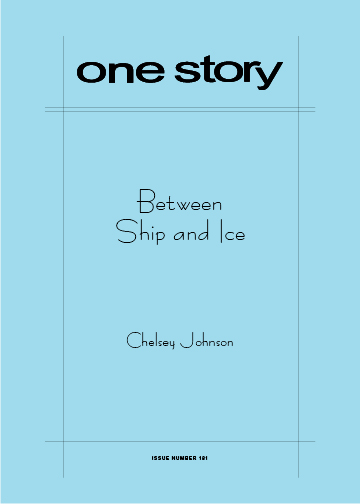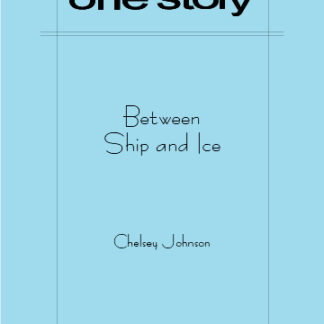
Between Ship and Ice
$2.50
51 in stock
Excerpt
It had been nine months since Synneva had seen her father, since he had left her family and returned to Norway. The man walking toward her in the Oslo airport looked taller, trimmer. Younger. He had a sleek haircut and angular glasses. But when he wrapped her up in his arms, his jacket smooth and cool on her cheek, his torso warm and familiar, he smelled like last year, the last good year; he still smelled to her like home.
“Lillevenn,” he said, nuzzling her hair.
“Hei, pappa,” she said into his chest.
“I’m so glad you’re here.” He clutched her shoulder.
She closed her eyes and nodded.
Last January, Synneva’s father had some kind of New Year’s revelation and abruptly decided he needed to go back to the country he came from—for good, and alone. Now he had flown Synneva here to see him—He still wants you in his life—her mother had said, tight-lipped, as she smothered the contents of Synneva’s suitcase with a final heavy sweater.
Her father gathered the suitcase now, pulling it from the conveyor belt.
“Are you ready to see some bears?” he asked.
Chelsey Johnson
Chelsey Johnson’s stories and essays have appeared in Ploughshares, the Rumpus, Avery Anthology, and NPR’s Selected Shorts, among others. She received an MFA from the University of Iowa and a Stegner Fellowship at Stanford. Currently she lives in Richmond, Virginia and is an assistant professor of English at the College of William & Mary. A novel is underway.
Adina Talve-Goodman on “Between Ship and Ice”
Our new issue, “Between Ship and Ice,” follows the strained relationship of a father and daughter, at the crossroads of both identity and adulthood. Adina Talve-Goodman, One Story’s managing editor, pulled this story from our slushpile, and acted as issue editor, so I’ll be turning the introducing reins over to her. I hope you’ll all enjoy this unique tale, set on the polar ice of Norway. Skål! — HT
When I was around ten years-old, a friend told me she wanted to have a polar bear as a pet. “It would probably eat you,” I said. We argued about whether or not she could train the polar bear to sit when she commanded, like her dog. She said she could. I said it would still be a polar bear and that her dog never really sat when she told him to. We never resolved the issue.
Perhaps it was the memory of that conversation that drew me to pull “Between Ship and Ice” by Chelsey Johnson from our submissions. More likely, it was the quiet nature of the story and the skillful shifting of points-of-view while Synneva, a seventh grade girl, and Erlend, her estranged father who has recently come out to all but his daughter, trek across Svalbard in search of polar bears. Along the way, Synneva and Erlend are on parallel tracks—discovering new lives independent and yet complicatedly bound by missing the other. The question of whether the two will find each other again looms. You can find out more about how Chelsey crafted these two unique voices and learned to speak Norwegian in her Q&A.
So, in these hot summer days, I’m happy to present this story filled with ice floes, snowmobiles, Norwegian folklore, and, yes, polar bears.
Q&A by Adina Talve-Goodman
- AT: Where did the idea for this story come from?
- CJ: The seed was a trip I took with my father when I was twelve to Churchill, Manitoba. It was profound and intoxicating to face polar bears that closely, even from the high armored safety of a tundra buggy—to know that these animals could kill me, and yet all I wanted was to get closer and closer. I started writing the story from that idea: tour group, bears, stark open landscape, how far away we were from our normal lives, the safe peril we were in. But the resemblance to my actual experience ends almost immediately there. I shifted the story to Svalbard because it’s more extreme than Manitoba. I wanted to amplify everything: the landscape, the tension, the danger, the pull of desire. I wanted to stir up trouble.
- AT: You switch between Erlend and Synneva’s points of view throughout the story. Why did you choose to do this? Was there one point of view that was easier to write than the other?
- CJ: When I wrote the first draft, I was in my twenties and still working out the complexities of youth in my fiction. The story was Synneva’s alone. She didn’t know Erlend’s reasons, and neither did I. The story felt dreamy and oversaturated, incomplete—it listed too heavily to one side and I couldn’t figure out how to right it. When I returned to it again in my thirties, my attention went right to Erlend. He had to be more than just Dad Who Bailed. He had his own secrets and longings. Coming out later in life, he’s going through his own second adolescence that sort of parallels his daughter’s. If there’s one supernatural power I could experience in this lifetime, it would be the chance to inhabit the head (and body) of another person—my neighbor, the bus driver, a stranger on the street, I don’t care who it is or whether it’s for a day or five minutes, I am dying to know how two different people experience the same moment. Shifting point of view is the closest you can get.
- AT: When did you first hear the fairy tale Kvitebjorn Kong Valemon? Who told it to you?
- CJ: At Skogfjorden, a.k.a. Norwegian camp. Such a thing exists in northern Minnesota, an hour from where I grew up, and it occupied decades of my life. You say “Norwegian camp” and people start to laugh, but it really was (and is) the strangest, most magical place, a tiny friendly nation where one hour you are a troll in a burlap sack and the next you’re a diplomat on the Nobel Peace Prize committee. The genius of Norwegian camp is that for weeks at a time, no matter the activity, you are immersed in language and constructing narrative. You learn (and create) a lot of stories. “Kvitebjørn Kong Valemon” is also known as “East of the Sun, West of the Moon.”
- AT: There’s a lot of description of Norway in the story, including a remark on all the women having great haircuts. You also move easily between English and Norwegian in the dialogue. What’s your relationship to Norway? Are you fluent in Norwegian? Is seal better than a burger?
- CJ: Norway is my second cousin twice removed. Our bloodlines forked across the Atlantic a few generations back but we remain tight. After my camper youth, I spent a summer in the fjords and a semester in Oslo, fell in with a good crowd, and returned over and over to stay with friends and travel the country as long and often as I could afford. I also taught at the camp and brought a group of teenagers to Norway. I am more or less fluent in Norwegian, which makes up for its debatable use-value in sheer delightfulness to speak. When in Norway I am one of circa six vegetarians in the country, so all I can tell you about seal meat is that it looks small and dark and intense in the butcher-shop window.
- AT: How long did it take you to complete this story?
- CJ: I delivered the first draft of “Between Ship and Ice” to workshop when I was at Iowa in 2002. Another to the Stegner fellows in 2004. I returned to it only briefly a few times over the years, and then a couple of years ago I cracked open the Erlend code and it all came together. Now that it’s going to print in 2013 I can finally call it done. My first week of grad school Chris Offutt brought a four-inch-thick folder of drafts to a seminar, dropped it on the desk with a dramatic thud, and announced to us that it was one story, and he’d worked on it for eight years. I didn’t know whether to be impressed or feel sorry for him. My idea of “revising” was a round of tweaks after workshop, and on to the next rush of new story. Now I’ve come to love the LTR over the brief torrid affair. I discovered the pleasure in the vision part of revision, and letting a story rest.
- AT: What are you working on now?
- CJ: A story about a bison ranch; a novel that takes place in Portland, OR and Bemidji, MN in the late 1990s; and a syllabus for my advanced fiction workshop.
- AT: What is the best bit of advice about writing you have ever received?
- CJ: I’ve sponged up so much good advice over the years it’s hard to squeeze out one clear bon mot. Like anyone who took a workshop from Frank Conroy, I’ve been indoctrinated with meaning, sense, clarity and meditate on the text! and put pressure on the language and prose that cannot be bent. I could quote you almost all of Charles Baxter’s Burning Down the House: Notes on the Craft of Fiction, a revelation every time I read it. But I guess one thing that’s guided me across all the genres is something the music and culture critic Greil Marcus said, that it’s the critic’s job not to lie. You have to really honestly assess what it is you’re dealing with, whether that’s a record album, a plausibility issue, a pretty sentence you’re too attached to, a character’s motivation, or your own. You can’t cheat or outwit what the real story wants to be. The characters can lie like crazy, but the writer can’t.
